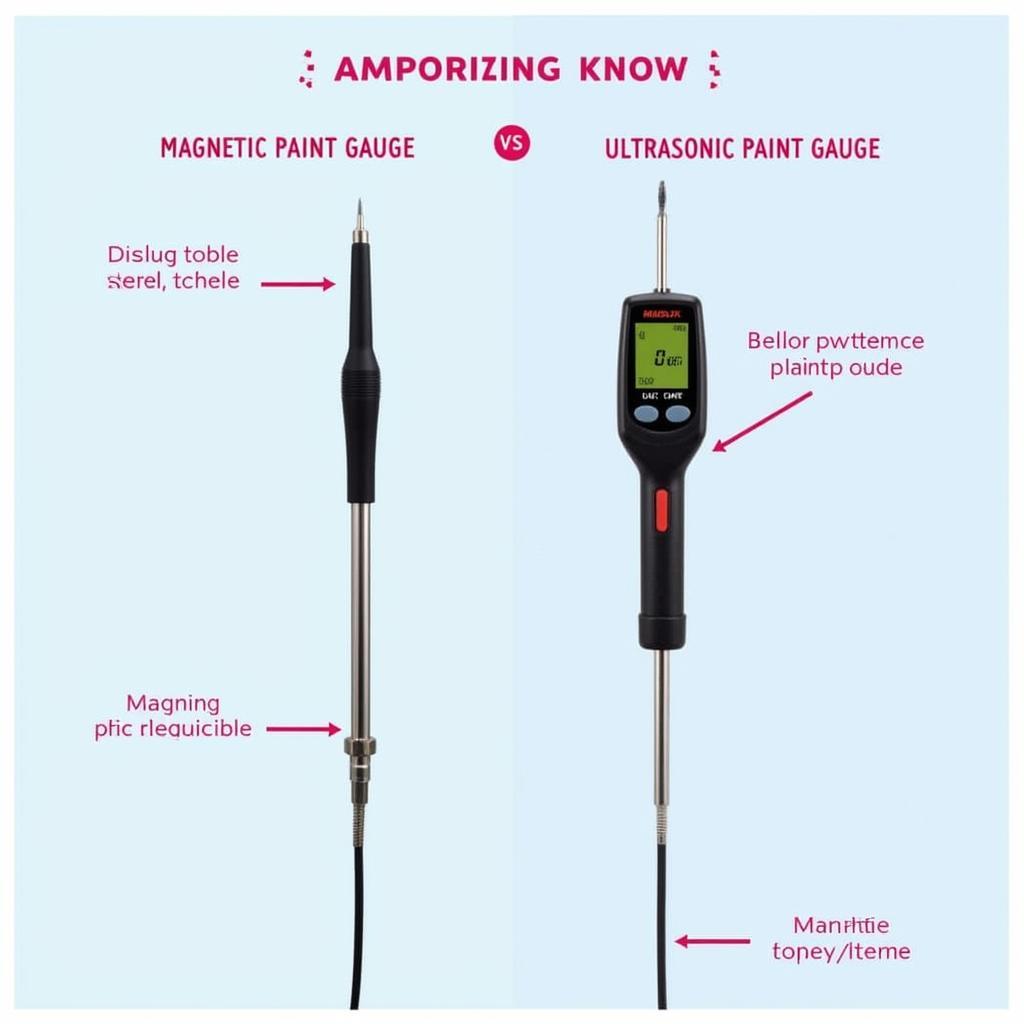A Car Detailing Paint Gauge is an essential tool for any professional detailer or serious car enthusiast. It allows you to accurately measure the thickness of a vehicle’s paint, revealing potential resprays, body filler, and other imperfections that might be invisible to the naked eye. This information is crucial for assessing the true condition of a car’s paintwork and planning the appropriate detailing steps.
Choosing the right car detailing paint gauge can be daunting, given the various models available on the market. This article will provide a comprehensive guide to understanding car detailing paint gauges, covering everything from their functionality and benefits to different types and essential features. We’ll equip you with the knowledge to make an informed decision and choose the best gauge for your needs.
Why Use a Car Detailing Paint Gauge?
A paint gauge provides valuable insights into the history of a vehicle’s paintwork. By measuring paint thickness, you can identify areas that have been repainted or repaired. This information is essential when:
- Assessing the Value of a Used Car: A car detailing paint gauge can help you determine if a used vehicle has been in an accident or has undergone significant bodywork. This knowledge can be crucial in negotiating a fair price.
- Inspecting for Previous Damage: Even minor accidents can result in resprays. A paint gauge will reveal these hidden repairs, ensuring you’re fully aware of the vehicle’s history.
- Planning Detailing Work: Knowing the paint thickness is vital for planning paint correction procedures. This ensures you don’t remove too much clear coat during polishing.
Thinking about car detailing in Cornwall? Check out cornwall car detailing.
Types of Car Detailing Paint Gauges
There are two main types of car detailing paint gauges:
- Magnetic Gauges: These gauges use a magnet to measure the distance between the probe and the metal body panel. They are generally more affordable and easier to use, making them a good choice for beginners.
- Ultrasonic Gauges: These gauges use ultrasonic waves to measure the paint thickness. They are more accurate and can measure paint on non-ferrous metals like aluminum and fiberglass, but they tend to be more expensive.
Choosing the Right Gauge for You
Which gauge is right for you depends on your specific needs and budget. If you’re a professional detailer or frequently work with a variety of vehicles, an ultrasonic gauge is recommended. For occasional use or assessing personal vehicles, a magnetic gauge might be sufficient.
Need car detailing in Victoria, MN? Visit car detailing victoria mn.
 Comparing Magnetic and Ultrasonic Paint Gauges
Comparing Magnetic and Ultrasonic Paint Gauges
Key Features to Consider
When choosing a car detailing paint gauge, consider these essential features:
- Accuracy: Look for a gauge with high accuracy and a low margin of error.
- Measurement Range: Ensure the gauge can measure the typical paint thickness range found on vehicles.
- Display: A clear and easy-to-read digital display is crucial for quick and accurate readings.
- Calibration: Some gauges require regular calibration to maintain accuracy.
- Durability: A robust and well-built gauge will withstand regular use and provide reliable performance.
“A quality paint gauge is an investment that pays off in the long run. It provides essential information for assessing a vehicle’s condition and making informed decisions,” says David Miller, a certified car detailing expert.
How to Use a Car Detailing Paint Gauge
Using a car detailing paint gauge is relatively straightforward:
- Clean the surface: Ensure the paint surface is clean and free of debris.
- Calibrate the gauge (if necessary): Follow the manufacturer’s instructions for calibration.
- Place the probe on the paint surface: Hold the gauge perpendicular to the surface.
- Read the measurement: The gauge will display the paint thickness in microns or mils.
- Repeat the process in different areas: Take multiple readings across the vehicle to identify any variations in paint thickness.
Looking for car detailing in Chester? Explore chester car detailing.
Conclusion
A car detailing paint gauge is an invaluable tool for anyone serious about car care. It provides critical insights into the condition of a vehicle’s paintwork, enabling informed decisions about purchasing, detailing, and maintenance. By understanding the different types of gauges, their features, and how to use them effectively, you can take your car detailing skills to the next level. Investing in a quality car detailing paint gauge is an investment in preserving the beauty and value of any vehicle.
FAQ
- What is the ideal paint thickness for a car? The ideal paint thickness varies depending on the make and model of the vehicle.
- How often should I calibrate my paint gauge? Refer to the manufacturer’s recommendations for calibration frequency.
- Can a paint gauge detect body filler? Yes, a paint gauge can indicate areas with excessive body filler by showing significantly higher readings.
- What are the units of measurement for paint thickness? Paint thickness is typically measured in microns or mils.
- Are magnetic paint gauges suitable for all car types? Magnetic gauges are not suitable for measuring paint thickness on non-ferrous metals.
- What is the difference between a mil and a micron? A mil is one-thousandth of an inch, while a micron is one-millionth of a meter.
- Where can I buy a car detailing paint gauge? Car detailing paint gauges are available from automotive supply stores and online retailers.
Want the best car detailing in Dunedin? Visit dunedin car detailing. Or maybe you’re interested in Bubba’s? Consider Bubba’s Car Wash and Detailing.
Need help with car detailing? Contact us via WhatsApp: +1(641)206-8880, Email: [email protected]. We have a 24/7 customer support team.

Leave a Reply